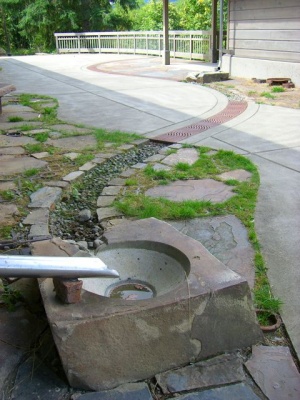Difference between revisions of "Downspout disconnection"
Jenny Hill (talk | contribs) (Created page with "<p>In many older urban centres, downspout disconnection program require that residents retroactively disconnect downspouts. This is due to older sewer systems being undersized...") |
Jenny Hill (talk | contribs) m |
||
| (36 intermediate revisions by the same user not shown) | |||
| Line 1: | Line 1: | ||
| − | + | [[File:David Elkin downspout disconnection to constructed stream channel.jpg|thumb|Downspout routed to an [[infiltration trench]]. A decorative [[trench drains|trench drain]] cover is visible in the background.]] | |
| + | Downspout disconnection programs are common in many older urban centers. They require that residents retroactively disconnect their downspouts from the municipal sewer system. This is due to older sewer systems being undersized for the combined flow of sanitary waste and stormwater. New projects should consider remaining independent of municipal storm sewers from the outset. To prevent [[flooding]] and achieve stormwater control, widespread use of small, site scale technologies such as downspout disconnection can reduce the size of shared LID installations. | ||
| − | + | The Ontario Building Code<ref>Province of Ontario. (2018). O. Reg. 332/12: BUILDING CODE. Retrieved February 23, 2018, from https://www.ontario.ca/laws/regulation/120332</ref> requires that: <br> | |
| − | "Where downspouts are provided and are not connected to a sewer, extensions shall be provided to carry rainwater away from the building in a manner that will prevent soil erosion." | + | "Where downspouts are provided and are not connected to a sewer, extensions shall be provided to carry rainwater away from the building in a manner that will prevent soil erosion." |
| + | {{textbox|1= Recommended strategies to receive downspout runoff include: | ||
| + | *[[Rain barrels]] | ||
| + | *[[Rain gardens]] | ||
| + | *[[Infiltration trenches]]}} | ||
| + | ---- | ||
Revision as of 20:23, 8 March 2018

Downspout disconnection programs are common in many older urban centers. They require that residents retroactively disconnect their downspouts from the municipal sewer system. This is due to older sewer systems being undersized for the combined flow of sanitary waste and stormwater. New projects should consider remaining independent of municipal storm sewers from the outset. To prevent flooding and achieve stormwater control, widespread use of small, site scale technologies such as downspout disconnection can reduce the size of shared LID installations.
The Ontario Building Code[1] requires that:
"Where downspouts are provided and are not connected to a sewer, extensions shall be provided to carry rainwater away from the building in a manner that will prevent soil erosion."
Recommended strategies to receive downspout runoff include:
- ↑ Province of Ontario. (2018). O. Reg. 332/12: BUILDING CODE. Retrieved February 23, 2018, from https://www.ontario.ca/laws/regulation/120332